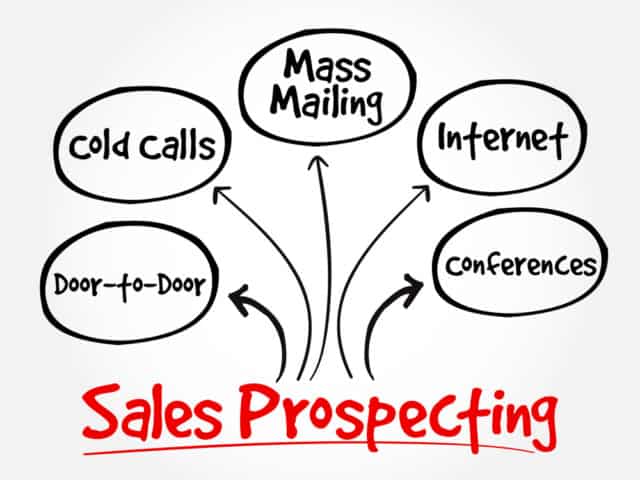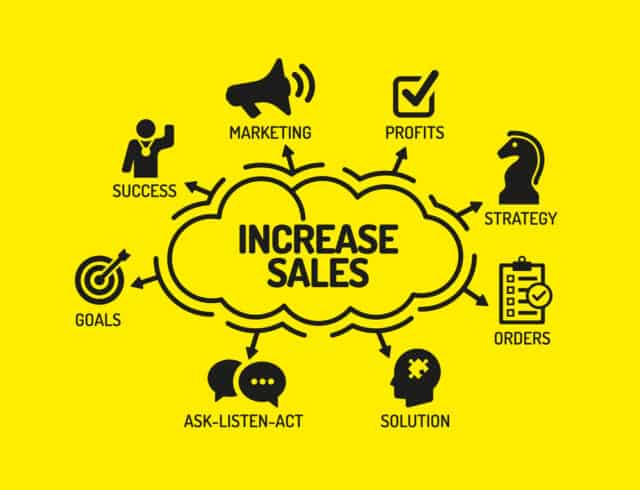Why Sales Prospecting Process is Absolutely Important for Every Sales Cycle?
Prospecting is the process of identifying potential customers and persuading them to buy from you. Prospecting answers a fundamental question. Which companies are interested in purchasing the products and services you’re providing?

Cold calling, emailing, SMS messaging, and other forms of outreach could be used to nurture dormant leads or reach out to entirely new people who could be future customers. This also includes investigating quality leads and classifying them according to their chances of conversion. It’s not easy. However, if you know what you’re doing, it is feasible.
What is the definition of prospecting?
Prospecting is a challenging task. It’s a methodical, comprehensive, and precise procedure. Long hours are spent finding prospects, sending messages, and making calls to numbers; it’s a demanding procedure for the most part.
It’s all about getting prospects. And who exactly is a prospect? A qualified lead with a higher probability of becoming a customer is referred to as a prospect.
Where will prospecting fit into the sales funnel or process?
The prospecting process identifies prospective clients and gains their interest in your product or service. It’s the first step towards closing sales. However, it can be challenging to get started if you don’t know where to start.
That is why prospecting is so crucial. The sooner you identify prospects with goals and problems that your solution solves, the more likely they are to become paying clients.
What is the definition of sales prospecting?
Sales prospecting is a lot like dating. It’s an important part of sales management. Sales prospecting is described as when inside sales reps pick up the phone and start making outbound calls and send outbound emails to leads in order to generate leads.
For many salespeople, it is also one of the most difficult aspects of selling. It doesn’t have to be difficult or time-consuming, though.

Also, what’s not sales prospecting?
Sales prospecting isn’t the buying process of a pre-made list of possible clients based on a few criteria so that salespeople can make cold calls all day and pass their work time.
Identifying potential consumers used to be as simple as going through the yellow pages or giving a list to a telemarketing company. This isn’t sales prospecting, and it’s certainly not a process.
When Should the Sales Team Prospect?

Even if you don’t need to locate new prospects, make sales prospecting a regular practice. A corporation that is a negative fit today may become a solid potential customer in the future if circumstances change. Fortunately, today’s technology allows you to automate a large portion of your sales prospecting process. These events, known as buying signals, can be tracked using intelligence systems.
Various methods for locating potential buyers
-
Inbound marketing
Inbound Marketing is a type of marketing that focuses on generating leads through content marketing and SEO. Inbound prospecting is based on nurturing leads who have approached you.
A blog post or a lead magnet may have brought them to your company’s website. Inbound prospecting takes a more tailored approach to each lead. Moreover, they’ve come to you, so there’s a better chance they’ll tell you exactly what they want. This makes it easy to answer their concerns and requirements.
-
Networking and referrals
Networking and referrals, which are built on connections, are examples of offline sources. The most common example of an offline source is a phone book or yellow pages. In addition, offline sources can include people who have been referred by someone else.
For instance, if you were looking for a piece of relevant information about a dentist, you could ask your friends, family members, or mutual connections about their experiences with dentists. You could also be able to learn more by using social media sites like Facebook, Twitter, or LinkedIn.
-
Social selling
Social selling is a type of selling that is focused on social networking channels engagement. It’s important to note that this form of marketing requires connecting with potential customers online, and it takes time to build up your following.
You can attract the prospect’s attention. You can also expect to have an organic reach of about 1% – 3% for every post or tweet you make on your social media channels. This means that if you want to see actual results or nurture leads from your efforts, then you need to be patient and engage regularly.
-
Outbound sales prospecting
Outbound sales prospecting is in the process of locating and contacting potential buyers. This is when you send messages to your target audience to entice them to join your company.
This method of prospecting focuses on word-of-mouth, email marketing, magazine advertisements, and cold-calling.
Outbound prospecting is when your sales reps initiate contact with potential customers. They’re ringing their phones at work or sending messages to their inboxes. Outbound prospecting might turn off prospects if done incorrectly.
Approaches of Sales Reps

Each of the approaches mentioned above has drawbacks. Inbound marketing is a resource-intensive, long-term strategy that is heavily reliant on the marketing team. Referrals aren’t always enough, and networking isn’t always a sure thing for qualifying leads.
Outbound prospecting, on the other hand, gives salespeople control, allowing them to become adventurers. Traditionally, almost every company relied on sales teams, pitch, and prospecting efforts to bring in new customers.
Inbound got stronger as potential customers became more discerning and intelligent, and businesses saw this technique as a solution to their prospecting challenges. The marketing team’s goal was to bring in as many leads as feasible to the website and then send the right ones on to sales processes.
Sales figures and revenue-generating customers will both benefit from a methodical sales prospecting approach. More significantly, thorough prospecting will guarantee that your outreach is skilled and suitable at every stage of the sales process, ensuring that you deliver immediate benefit to the prospect.
Today’s fastest-growing companies utilize a combination of sales prospecting and lead generation to find new customers.
By integrating valuable intelligence from company data given by sales tech with actionable information from company data provided by sales tech, companies can target warm prospects and be more effective in every point of the sales process.
What makes a sales lead different from a sales prospect?
It’s worth noting that the terms “prospect” and “lead” are not interchangeable. Every lead is a prospect; however, not every prospect is a lead.
The first people that enter your sales process are leads. They are potential customers who have expressed interest in your product by signing up for your newsletter, downloading an ebook, or reading your most recent blog post. They aren’t a perfect match for you right now, though.
Lead conversations are usually one-sided; they may check your content but are unlikely to contact you or respond to your emails. On your email list, they’re effectively strangers. A prospect is a lead who is more likely to be converted into a customer. Hence they should be further down the sales pipeline.
Why is Sales Prospecting Important?
Sales prospecting is an important aspect of the selling process. It’s one of the first steps you take to find new clients, and it can help you grow your business. You might not get anywhere if you wouldn’t do it correctly. You need to know how to ensure that every step in the sales cycle is working for you.
To fully appreciate the value of sales prospecting, you must first understand the sales process and how consumers make purchasing decisions.
-
Build Your Pipeline:

Sales prospecting is critical to your company’s growth. If you don’t have a system in place to develop the sales pipeline, your sales team will find it difficult.A pipeline is critical for business growth since it shows what has been completed, whatever is being worked on now, and who you want to target. It also holds the sales representative responsible for the objectives they establish for themselves.
Without a sales funnel, none of this is feasible, and without action documents, your organization will be left with additional unanswered questions. Begin small. As a result, collaborate with your team to determine who your ideal consumer is. Build personas and KPIs that can be evaluated, reviewed, and adjusted as necessary.
-
Become a Trustworthy Advisor
Prospecting for sales entails a lot more than what the phrase implies. In this job, you are a valuable advisor for the organization you serve.
You’ll need to emphasize empowerment and learning/choices that can lead to prospecting to keep your staff fresh.
Prospecting for sales adds a personal touch to your team. Each phone or cold call, email, and networking message is another opportunity to discover themselves and provide value to a potential target.
-
Boost your productivity

The addition of sales prospecting staff boosts productivity. To begin, track the results of their prospecting activity in a CRM to understand their relative strengths and weaknesses.This allows you to spot inefficiencies and gradually improve efficiency. Second, even if it’s simply an Excel spreadsheet, you’ll need a monitoring system that gives your team a point of access to the leads you’re trying to pursue. Finally, you’ll need a strategy for sales prospecting. This allows you to zero in on your ideal customer, ensuring that you aren’t wasting time on sales prospects that aren’t a good fit and, quite honestly, don’t matter to your company.
Focusing your team on the accounts that matter encourages them to make more voice calls, more messages, mailers, and other prospecting techniques.
-
Gather information on your competitors

Prospecting for sales is an easy approach to learn about your rivals. You obviously want to understand what other products and services your prospects may explore because the competition is tough. As a result, it is preferable to obtain detailed information.Prospective customers can provide you with invaluable insight on how to sell your products and/or services.
Make your marketing campaigns more effective by using sales tools, service offerings, and competitive data you gain from sales prospecting.
The plain truth is that sales prospecting is crucial to your company’s success. This not only fills your sales pipeline but also positions you as a trustworthy expert, boosts productivity, and gives you competitive advantages.
Your pipeline is essential to your continued existence. Prospecting for sales is the most effective approach to keep it going.
Decision-Making Process – How to approach new leads?
When firms began to customize marketing efforts to specific companies, account-based marketing became popular. This tendency of personalization is also making its way into sales.
What are the channels that the prospect prefers? What can you do to distinguish yourself from the crowd?
How can you identify an objective point of agreement that gives your connection traction? The following are the measures to take:
- Customer Relationship Management (CRM) should be emphasized.

- Find your way into their world by conducting research.
The foundation is laid by research. Read the investor report to see if the company is publicly traded. If it’s a tiny or medium business, set up Google alerts to understand about their press and
absorb everything they put out there about themselves.Opportunities and account insights allow you to add additional value to the table. You’re attempting to understand situations and people better so that when you reach out, you’re not just saying the right things but also saying them to the proper person. - Find a channel that you can stick to.

Earn the right to ask them their preferred method of contact, and then meet them there.
What is the most effective technique to qualify a sales lead?

Qualifying a prospect is critical, but don’t confuse “qualifying” with “deciding whether or not someone is relevant.”
Everyone you speak with is significant because if they aren’t the ideal person to talk with, they can refer you to someone who is. Here are some questions to ask to see if a prospect is a suitable match:
Is this a potential customer?
- Is the potential customer a good match as your ideal customer?
- Is your product already attracting their attention?
- Can they have an impact on the deal, or perhaps elect to purchase it?
Is this the perfect firm for you?
- Will it be in your territory?
- Would the industry be a perfect match for you?
- What is their company’s size? (Don’t just look at how many staff they have.) If you’re offering a subscription or usage-based service, consider the value of their consumption.
Is this the best project for me?
- Is the department well-funded enough to cover your costs?
- Will the corporation make the initiative a priority this year?
- Will the team use the product for the proper use case — and in a way that makes a difference?
What can I do to take sales prospects to the next level of the sales process?
Research is important, but you’ll need more to take the debate to the next level. After all, prospects can quickly investigate us just as easily as we can research them. We won’t go ahead with them if we keep repeating broad facts from your website.
How are you going to get into their heads and give them information that nobody else has? You’ll need to study their accent as well as their language, as well as learn about their job lives. This entails becoming knowledgeable about specific trends in their sectors, businesses, and even personal life.
How can I keep the discussion going?
Think about more than just finishing the deal. Consider closing each phase of the transaction. It’s easy to get carried away in your eagerness to advance the discourse. Obsess over the following steps, for example: Remember to ask a question at the end of every talk.
- “Can we talk for five minutes after you look at it?”
- “Is there somebody on your team with whom I could collaborate on that?”
- “Can you recommend someone to ask if you aren’t the right person?”
Advance, but only if you qualify.
It’s all about pushing forward in prospecting. But don’t put too much emphasis on an offer that isn’t worth your time. As the conversation progresses, you must continue to qualify at the same time. At each level, check to see if the prospect is still a good fit. The qualification also entails ensuring that they are prepared to advance to the next level.
You probably don’t know everything, but someone else will.

If it comes to sales, it’s a team sport. To obtain the information you require, you must rely on everyone possible. Request that the latest domain be taught to you by your company’s technical experts.
To assist you in planning out a solution, reach out to technical and digital consultants. Inquire about Marketing’s assistance with a new pitch. You are not required to do this on your own.
Are you ready to put your best-prospecting strategies into action on a large scale?
Sales Cadences allows sales managers to assign steps to salespeople, such as when to email vs. call, what call script to utilize, and what material to send if they decline. Inside sales staff can work through their prospects at breakneck speed using sales cadences.
Sales cadences include things like sending emails, making calls, scheduling meetings, and sending a text. Leads, contacts, and personal accounts can be added to the sales cadence by sales managers and sales reps.
Sales professionals respond to cadence activities based on a prioritized work queue that shows them which prospects are ready for each outreach at a glance.
Examine your prospecting plan to determine where improvements might be made.
Keep track of which actions added value to the prospecting process and which were a waste of time throughout the process. Following each interaction with a prospect, we should evaluate how well we:
- Unrecognized difficulties.
- Assisted in the formulation of well-defined objectives.
- Confirmed budget availability and comprehended the decision-making process.
- The consequences of inaction have been determined.
- Identify potential success outcomes.
- This self-reflection will aid us in the future in improving our sales prospecting strategies.
Proven Prospecting Techniques & Strategies for Sales Reps

According to research, 81.6% of top-performing salespeople spend at least 4 hours each day on sales-related tasks. Because prospecting isn’t usually the most enjoyable activity, scheduling this time with yourself will go a long way toward ensuring that it occurs regularly.
The advantages of such a discipline are numerous: a lead-filled sales pipeline increased conversion chances and higher win rates!
10 Trending Sales Prospecting Tips
Prospecting is the most difficult part of the sales process for 42 percent of sales professionals, according to research findings. So, is it really so challenging? We’ve put together a list of 10 hot sales prospecting strategies that will transform the way you go about getting new leads and turn you into a lead-generating machine.
-
Create a prospect profile that is ideal for Sales reps
There are numerous types of people, industries, and business sizes to choose from. According to new research, fifty percent of your prospects aren’t a suitable fit for your service offering.
It’s also important to think in “pain points” and “problem-solution” terms, which means figuring out what pain issues your ideal customer might have and how your product addresses them.
After you’ve completed your homework, you may use your profile list as well as your existing company list to identify more businesses that meet these requirements. This method, sometimes referred to as account-based marketing, allows you to focus on the bigger fish in the sea.
-
Think about how you can meet your ideal prospects
Begin by looking into how you meet your “best” consumers. Your “best” customers are usually the ones who bring you the most money. Was it at a conference or a trade show? Or through a referral? This will assist you in identifying your most “profitable” hangout spots.
Consider industry events or social organizations: what are the events or activities that your ideal prospects are likely to visit or participate in?
Finally, think about their digital footprint: which social media platforms, newsfeeds, and other online publications are they likely to use or visit? All of this information can help you plan a strategy for meeting potential customers at the right places.
-
Work on your call list on a routine basis
You have a cold call list, a warm lead list, and even a list of lost leads. Make a priority list for each list, and then set aside time each day to phone the people on it. You don’t need a rehearsed sales speech; instead, you need a conversation in which you can learn about their pain areas, requirements, and wishes, as well as where they are in the decision-making process. Qualified leads become a lot easier if you can sustain an engaging discussion.
Make a follow-up call in 6 weeks or 6 months. It’s all about remaining connected at the end of each day. You’ll be able to transform tepid leads into warmer leads, which will subsequently become burning leads.
-
Personalize your emails

Do not assume that email is no longer a viable sales tool. Personalized emails are now in charge, with a 26% greater open rate than mass emails.First and foremost, make sure that the material is suited to each prospect’s individual needs. Your aim is to entice them with your understanding of their industry or business. Make sure the content is tailored to a certain prospect’s requirements.
Second, make sure your email looks well on mobile devices so that your leads will access and view it, as more than 50% of all emails are consumed while on the go. Emails that have been designed for mobile devices have a 15% higher click-through rate than emails that are not.
-
Seek referrals
Nothing beats a satisfied customer since happy customers spread happiness. As a result, it’s no surprise that 91 percent of B2B buyers are impacted by word-of-mouth when making purchasing decisions, with a 50 percent to 70% referral-based transaction closing ratio.
Ask your consumers for referrals. There’s a no-cost chance you can’t afford to pass up. The ideal time to ask for a referral is right after the sale is completed when the customer’s memory of the experience is still bright.
Maintaining contact with existing clients is also necessary to guarantee that they are satisfied with your product or service. Set up sales meetings to simply say hello and check in on things.
-
Learn everything there is to know about
However, to earn those referrals, you must go beyond being a sales rep or a vendor. You must be like an executive vice president of the marketing department, i.e., a dependable specialist and a solution provider. This implies that you must be well-versed in:
- The industry you’re aiming towards.
- Customers who might buy from you.
- Your own service/product
-
Establish a social media presence

If you haven’t already worked it out, social networking tools aren’t going anywhere. Instagram, Facebook, Twitter, LinkedIn, and YouTube are just a few of the places where potential purchasers go to get information. As a result, someone else will turn up if you don’t! Keep in mind that having a social media presence is an addition to your prospecting arsenal, not a substitute.
-
Send prospects information that they will find useful
Although we all know how content aids salespeople in moving prospects through the sales funnel more quickly, we may not know what type of material to send or when to send it. Consider what you’re aiming to accomplish in the prospecting stage to answer this question.
You want your most qualified lead or potential buyer to either pay attention and meet with you or go on to the next stage, correct? This indicates that the content you deliver should be tailored to the prospect’s individual needs and pain points. Demonstrate that you understand where they are in the purchase process, what their obstacles are, and that you can contribute expertise, ideas, and insights to help them progress.
-
Use video to demonstrate your selling abilities
This is by far the most popular sales prospecting technique, and it’s one you haven’t tried yet! Recent trends indicate that video is becoming more popular as a marketing and sales outreach strategy.
Simple videos in which you, as a sales representative, show your face and start introducing yourself, give information, quote figures, and deliver your best sales pitch are acceptable. All of the standard stuff, but done uniquely. After all, people purchase from other individuals. So, show them who you are! This means that it’s time to go all video to attract an increasing number of visual buyers.
-
Follow Up
Finally, the results of your labor are not always apparent in the first interaction. It takes effort to transform a lukewarm lead into a scorching one. This includes sending follow-up messages, making multiple phone calls, forwarding further information, and other follow-up tasks.
Follow-ups on time are a dependable technique to create a relationship and exhibit your commitment and reliability. Anything you do to increase your chances of generating more sales, from a simple “just checking in” or “thank you” message to providing a draft proposal or product specs on time, counts.
If you don’t get a response to your email in 24 hours, according to the study, you should follow up since “you have a 21% probability of receiving a response to your second message after the first goes unanswered.”
Conclusion
Let’s be honest: prospecting isn’t nearly as exciting as sealing a sale. As a result, it is frequently postponed until all of the “essential things” have been completed. However, without a sales funnel filled with high-quality leads, no new sales would be generated.
That’s why it’s critical to recognize that prospecting kicks off the entire sale and, to a considerable measure, defines whether or not the purchase will be closed. Another thing to remember about prospecting is that leads don’t just materialize in your mailbox. You must act in order for something to happen.
The logic is simple: the more leads you produce, the more possibilities you have to close a transaction because each lead represents an opportunity. Regardless of the strategy, you employ to perform sales prospecting, the end result should be: which organization to contact, whom to contact there, when to communicate with them, and what to share. Prospecting is the act of determining the right people to contact at the appropriate time with the appropriate message. It’s just as vital to have a consistent time on your calendar to prospect every day as it is to schedule a specific time in your diary for daily workouts.
You must concentrate on people and accounts suitable for your product or service, just as you must in every other area of the sales process. Prospecting can be difficult if done incorrectly. However, when backed up with data, it’ll produce more exact results and lay the groundwork for a well-functioning sales process.
Subscribe to our Newsletter
Sign up to receive email updates on new product announcements, exclusive sales and marketing content, special offers on email validation plans, and more.
We send curated content as per your preference and do not indulge in spam!
What would you like to know about
We’re committed to your privacy. TuxMailer uses the information you provide to us to contact you about our relevant content, products, and services. You may unsubscribe from these communications at any time. For more information, check out our privacy policy.
